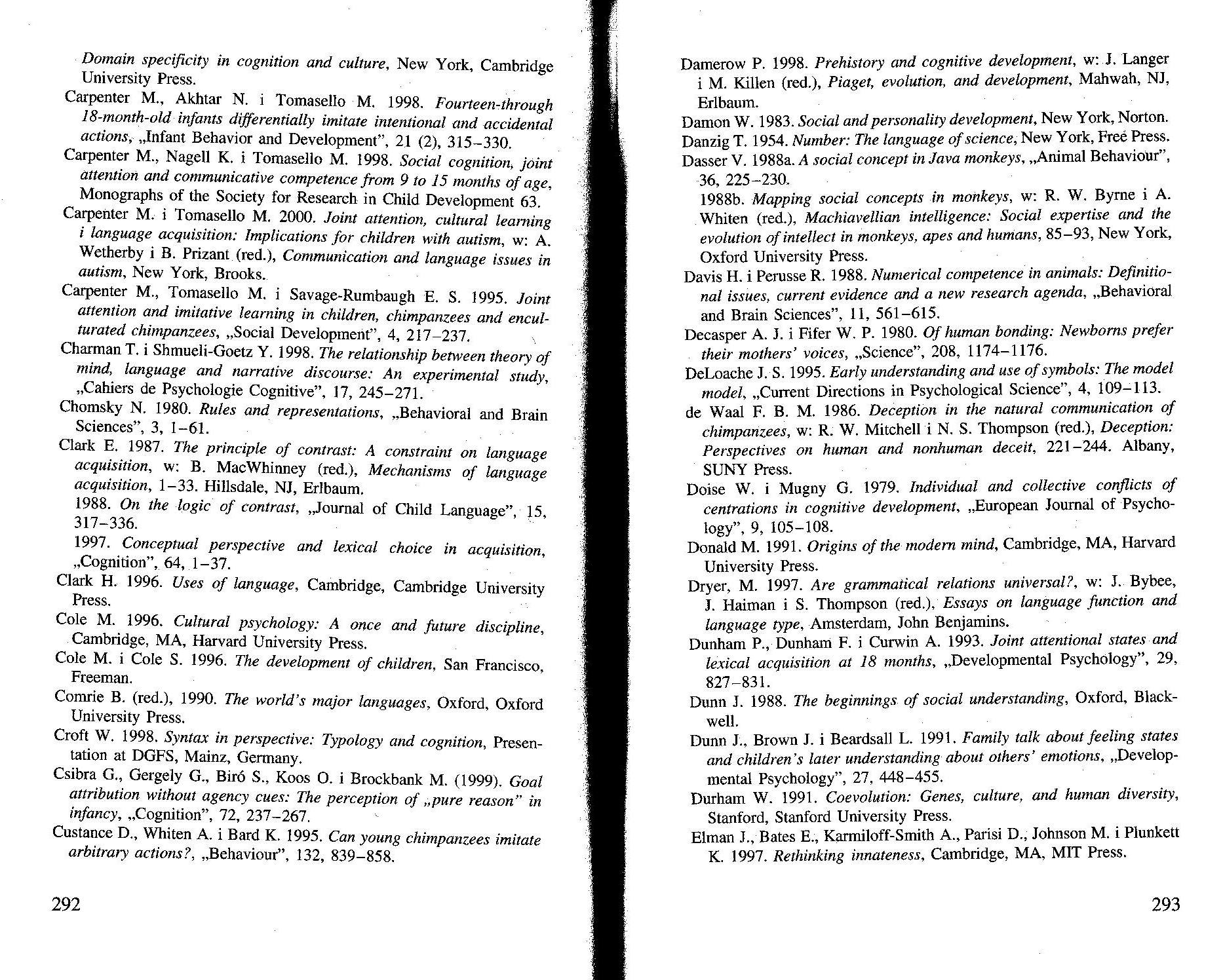CCF20090212�145

Domain specificity in cognition and culture, New York, Cambridge University Press.
Carpenter M., Akhtar N. i Tomasello M. 1998. Fourteen-through 18-month-old infants differentially imitate intentional and accidental actions, „Infant Behavior and Development”, 21 (2), 315-330.
Carpenter M„ Nagell K. i Tomasello M. 1998. Social cognition, joint attention and communicative competence from 9 to 15 months of age, Monographs of the Society for Research in Child Development 63.
Carpenter M. i Tomasello M. 2000. Joint attention, cultural leaming i language acąuisition: Implications for children with autism, w: A. Wetherby i B. Prizant (red.), Communication and language issues in autism, New York, Brooks.
Carpenter M., Tomasello M. i Savage-Rumbaugh E. S. 1995. Joint attention and imitative leaming in children, chimpanzees and encul-turated chimpanzees, „Social Development”, 4, 217-237.
CharmanT. i Shmuełi-Goetz Y. 1998. The relationship between theory of mind, language and narrative discourse: An experimental study, „Cahiers de Psychologie Cognitive”, 17, 245-271.
Chomsky N. 1980. Rules and representations, „Behavioral and Brain Sciences”, 3, 1—61.
Clark E. 1987. The principle of contrast: A constraint on language acąuisition, w: B. MacWhinney (red.), Mechanisms of language acąuisition, 1-33. Hillsdale, NJ, Erlbaum.
1988. On the logie of contrast, „Journal of Child Language”, 15, 317-336.
1997. Conceptual perspective and lexical choice in acąuisition, „Cognition”, 64, 1-37.
Clark H. 1996. Uses of language, Cambridge, Cambridge University Press.
Cole M. 1996. Cultural psychology: A once and futurę discipline, Cambridge, MA, Harvard University Press.
Cole M. i Cole S. 1996. The development of children, San Francisco, Freeman.
Comrie B. (red.), 1990. The world’s major languages, Oxford, Oxford University Press.
Croft W. 1998. Syntax in perspective: Typology and cognition, Presen-tation at DGFS, Mainz, Germany.
Csibra G., Gergely G., Biró S., Koos O. i Brockbank M. (1999). Goal attribution without agency cues: The perception of „pure reason” in infancy, „Cognition”, 72, 237-267.
Custance D., Whiten A. i Bard K. 1995. Can young chimpanzees imitate arbitrary actions?, „Behaviour”, 132, 839-858.
Damerow P. 1998. Prehistory and cognitive development, w: J. Langer i M. Kilłen (red.), Piaget, evolution, and development, Mahwah, NJ, Erlbaum.
Damon W. 1983. Social andpersonality development, New York, Norton.
Danzig T. 1954. Number: The language of science, New York, Free Press.
Dasser V. 1988a. A social concept in Java monkeys, „Animal Behaviour”, 36, 225-230.
1988b. Mapping social concepts in monkeys, w: R. W. Byme i A. Whiten (red.), Machiavellian intelligence: Social expertise and the evolution ofintellect in monkeys, apes and humans, 85-93, New York, Oxford University Press.
Davis H. i Perusse R. 1988. Numerical competence in animals: Definitio-nal issues, current evidence and a new research agenda, „Behavioral and Brain Sciences”, 11, 561-615.
Decasper A. J. i Fifer W. P. 1980. Of human bonding: Newboms prefer their mothers’ voices, „Science”, 208, 1174-1176.
DeLoache J. S. 1995. Early understanding and use of symbols: The model model, „Current Directions in Psychological Science”, 4, 109-113.
de Waal F. B. M. 1986. Deception in the natural communication of chimpanzees, w: R. W. Mitchell i N. S. Thompson (red.), Deception: Perspectives on human and nonhuman deceit, 221-244. Albany, SUNY Press.
Doise W. i Mugny G. 1979. Jndividual and collective conflicts of centrations in cognitive development, „European Journal of Psycho-logy”, 9, 105-108.
Donald M. 1991. Origins of the modern mind, Cambridge, MA, Harvard University Press.
Dryer, M. 1997. Are grammaiical relations universal?, w: J. Bybee,
J. Haiman i S. Thompson (red.), Essays on language function and language type, Amsterdam, John Benjamins.
Dunham P., Dunham F. i Curwin A. 1993. Joint attentional States and lexical acguisition at 18 months, „Developmental Psychólogy”, 29, 827-831.
Dunn J. 1988. The beginnings of social understanding, Oxford, Black-well.
Dunn J., Brown J. i Beardsall L. 1991. Family talk about feeling States and children’s later understanding about others’ emotions, „Develop-mental Psychology”, 27, 448-455.
Durham W. 1991. Coevolution: Genes, culture, and human diversity, Stanford, Stanford University Press.
Elman J., Bates E., Karmiloff-Smith A., Parisi D., Johnson M. i Plunkett
K. 1997. Rethinking innateness, Cambridge, MA, MIT Press.
293
Wyszukiwarka
Podobne podstrony:
P1010379 21. Lunatyczne kobiety Jon Muth Dracula; A Symphony in Moonlight and Nightmares,
CCF20090225�137 De Grazia S., Of Time, Work, and Leisure, New York, Twentieth Cen tury, 1962. Delos
musc dev055 institutions in and ucar -New York City, and my entire reputation stands behind tli
New Forms Taschen 066 $tcven Holi Storcfront for Art and Architecture New York, New York,
New Forms Taschen 067 A Pagos 72/73 St«ven Holi Storef ront for Art and Architecture
New Forms Taschen 067 A Pagos 72/73 St«ven Holi Storef ront for Art and Architecture
P5280928 Alina Orochoweka Problemu ot Blbllographlc SUndaidisaUon In Pol and AB8TRACT Togetlier wilh
72778 P1060385 (2) Derywacja stylu 53 Kroeber A. L. (1957): Style and civilizations. New York. Kuryl
44894 Week in a?y?ook3000 NEW YORK TIMES BESTSELLING AUTHORWEEKINADAY FIVE DISHES • ONE DAY RACHAEL
5 (2278) * E. R. Jaensch. EldetU Imagery, Marcourt, Bracc and Company. New York 1930. wyobraźnią3*.
Week in a?y?ook3000(1) NEW YORK TIMES BESTSELLING AUTHOR FIVE DISHES • ONE DAYRACHAEL RAY
więcej podobnych podstron